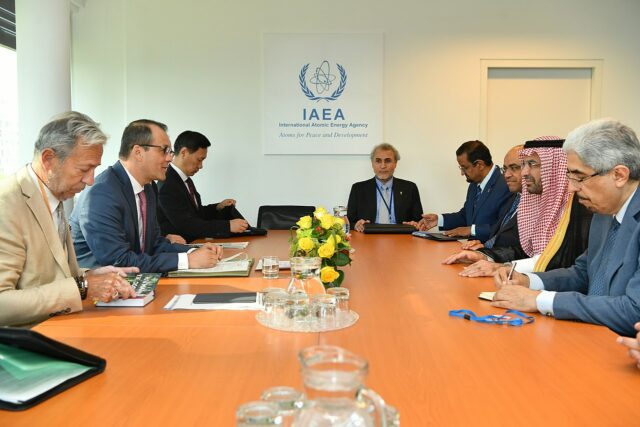Charting Saudi Arabia’s Nuclear Future: 4 Goals Shaping Global Dynamics

Geopolitical Report ISSN 2785-2598 Volume 33 Issue 13
Author: Guido Keller
The progression of Saudi Arabia’s nuclear energy initiative has prompted speculation within the international community. As the world’s foremost petroleum producer, the nation’s decision to engage with nuclear power facilities may seem unanticipated.
This analysis seeks to explain the underlying motivations for Saudi Arabia’s venture into nuclear energy, explore its collaborative affiliations and potential adversaries, and appraise the ramifications of its nuclear ambitions.
Saudi Arabia’s Nuclear Program: Background Information
The nuclear energy landscape in the Middle East is notably intricate, characterised by multifaceted geopolitical considerations. Nations endeavouring to acquire nuclear power capabilities invariably find themselves subject to the influence of regional allies, competitors, and Western powers alike. Nonetheless, the Middle East has borne witness to notable strides in nuclear energy advancement.
For instance, in 2013, Iran inaugurated the Bushehr Nuclear Power Plant, thus marking a pivotal moment as the first Middle Eastern nation to attain operational nuclear power capacity.
Similarly, the United Arab Emirates entered the nuclear energy realm in 2009 by contracting South Korea to construct the Barakah Nuclear Power Plant, which subsequently begun operations in 2020.
Saudi Arabia is also on a course to develop nuclear energy, following in the footsteps of many other nations. In 2010, Riyadh established the King Abdullah City for Atomic and Renewable Energy, aimed at fostering nuclear and renewable energy research initiatives.
Notably, a collaborative accord with France in 2011 signalled Saudi Arabia’s commitment to advancing its nuclear energy aspirations. Subsequently, in 2012, the government unveiled plans to expand the nation’s energy infrastructure by introducing a comprehensive framework involving twelve nuclear reactors.
In a strategic pursuit to diversify its energy portfolio, Saudi Arabia aspired to generate over 17 gigawatts of electricity through nuclear reactors by 2032. Collaborative agreements with South Korea in 2015 and China in 2017 further underscored the kingdom’s strategic intent to harness nuclear power capabilities.
The transition towards nuclear energy has been propelled by a confluence of political and economic imperatives. The escalating demand for electricity, spanning both domestic and industrial sectors, has catalysed the need for alternative energy sources. Concurrently, the desire to maintain parity with regional counterparts while fostering technological advancement has driven Saudi Arabia’s nuclear ambitions. Remarkably, nuclear energy aligns with the overarching “Saudi Vision 2030” strategy, encompassing eco-friendly energy sources and economic diversification beyond oil reliance.
In recalibrating its nuclear energy strategy, Riyadh has pivoted from the extensive deployment of reactors to a focused approach. The National Atomic Energy Project of Saudi Arabia (SNAEP) currently entails four core objectives. These include the construction of nuclear power plants boasting capacities ranging between 1200 to 1600 megawatts, the development of small modular reactors, the establishment of an end-to-end nuclear fuel cycle, and the creation of a regulatory framework governing the nuclear energy domain.
Integral to this effort is the imperative of securing uranium reserves to power the envisioned nuclear reactors. Assessments in September 2020 postulated that substantial uranium deposits are present within Saudi Arabia’s territory in the Persian Gulf. These reserves, potentially exceeding 90,000 tons, offer a tangible foundation for the kingdom’s nuclear energy ambitions.
Saudi Arabia’s energy minister, Prince Abdulaziz bin Salman, has openly acknowledged the nation’s uranium reserves, thus affirming the nation’s commitment to establishing a comprehensive nuclear fuel cycle. This proclamation, issued in January 2022, accentuated the kingdom’s determination to leverage its indigenous uranium resources.
Saudi Nuclear Power Plant: partners and opponents
The question of identifying suitable partners for constructing Saudi Arabia’s nuclear power plants engenders considerable deliberation. Presently, two nations have emerged as frontrunners for this endeavour: China and Russia.
In 2020, Russia’s Rosatom applied to construct a nuclear power station in Saudi Arabia. Equally significant, China has recently signalled its willingness to participate in the construction of nuclear power plants within the Gulf nation.
Indeed, Beijing has increased its efforts in the Gulf region by promoting the normalisation of Riyadh-Tehran relations and arising as a challenge for international actors actively involved in the area, especially the United States.
While speculation abounds, assessing Israel’s perspective on Saudi Arabia’s nuclear energy journey is of paramount significance. Israel’s stance is nuanced, influenced by diplomatic aspirations toward the Kingdom. Concurrently, Israel remains vigilant about the potential implications of Saudi Arabia’s uranium enrichment efforts. This vigilance is rooted in concerns that Saudi Arabia’s nuclear ambitions could culminate in the development of nuclear armaments.
Conclusion
Considering historical statements by Saudi Arabia’s Crown Prince Mohammed bin Salman showing a willingness to pursue nuclear weapons in response to Iran’s actions, Israel’s concerns are not unfounded. Nonetheless, the recent trend of diplomatic normalisation between Saudi Arabia and Iran shows a shift away from the intense nuclear arms race dynamics that once prevailed in the region.
In conclusion, Saudi Arabia’s journey toward nuclear energy is a pivotal development within its broader energy and economic trajectory. As the Kingdom strives to diversify its energy sources and reduce dependence on oil exports, transitioning to nuclear power is laden with intricate geopolitical intricacies. The choice of international collaborators will inevitably shape Saudi Arabia’s energy security, diplomatic relations, and global positioning in the years to come.
Do you like SpecialEurasia reports and analyses? Has our groundbreaking research empowered you or your team? Now is your chance to be a part of our mission! Join us in advancing independent reporting and unlocking the secrets of Eurasia’s complex geopolitical landscape. Whether through a one-time contribution or a monthly/yearly donation, your support will fuel our relentless pursuit of knowledge and understanding. Together, let’s pave the way for a brighter future. DONATE NOW and secure your place in shaping the geopolitical narrative.
